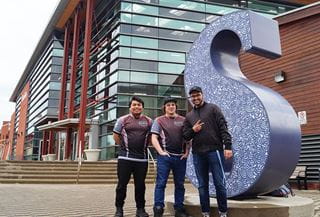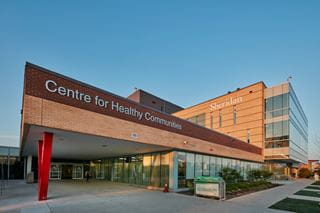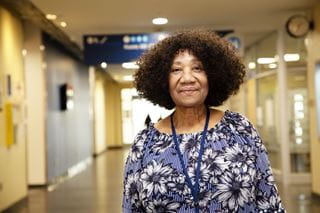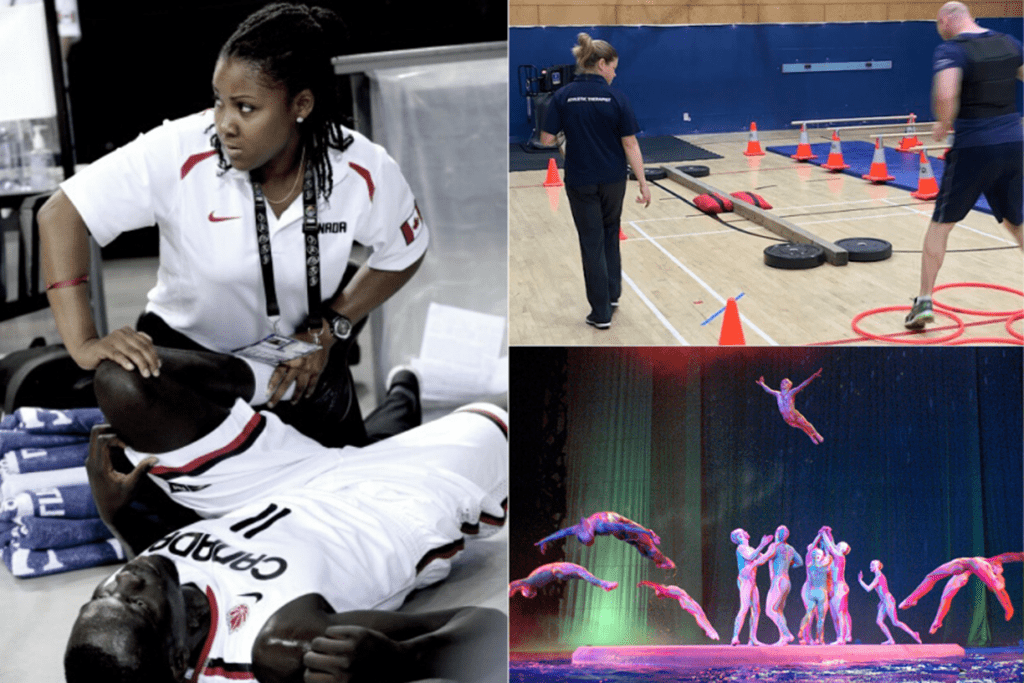
Putting Athletic Therapy to Work: Meet Six Alumni who are Defining the Field
 by Christine Szustaczek – Jan 17, 2020
by Christine Szustaczek – Jan 17, 2020 Michelle Bell, Colin King, Paul Papoutsakis, Miranda Sallaway, Becky Swan and Jennifer Johnson are Athletic Therapists who have put their skills to work in diverse industries. While their careers took different paths, they all share one thing in common: training in Sheridan’s renowned Athletic Therapy program. Check out profiles of these six alumni below and learn about the origins and evolution of Sheridan’s Athletic Therapy program in the story: Pioneers of Pedagogy and Practice.
Michelle Bell
Athletic Therapist, Ryerson University and Head Athletic Therapist – Cadette Women’s National Team, Canada Basketball

“The road to recovery begins with us.” These are the words used by Athletic Therapist Michelle Bell when describing the privileged position she holds working in the sports science and athletic performance industry. Currently, Bell oversees the varsity athletes at Ryerson University and is also entering her tenth season with Canada Basketball – the governing body for the sport in this country at the amateur level, up to and including our national team programs.
“We’re experts in our field when it comes to assessing and rehabbing musculoskeletal injuries. But it’s more than that. We almost become a life coach to our athletes. We see their tears. We see the heartache. But we also see the pride in someone working really hard to get themselves back from injury to where they used to be.”
Bell grew up playing competitive sports and faced several untimely injuries herself – something that taught her early on how to distinguish good treatment from bad treatment. Those experiences and her desire to stay connected to sports are what compelled her to pursue the career.
“My training at Sheridan literally provided me with the stepping-stone that has allowed me to reach where I am today,” she says. During the third year of her degree program, Bell earned a scholarship and placement with Team Canada, becoming the first female recipient of the award, making her the first woman to ever support the national men’s basketball team as an Athletic Therapist. She has since established her own summer internship with Ontario’s provincial team program that gives current Sheridan students in their third or fourth year the opportunity to work with her to support Canada’s elite basketball players.

While at Sheridan, Bell recalls the professors at Sheridan as being open and supportive, taking the time to develop the skills of their students and creating an environment that made it fun to learn. “I’m still friends with a number of them today,” she says. Their teaching style clearly has had a strong impact on her personal life and professional career. On a daily basis, Bell uses words of encouragement and positive goal setting to create an environment that leaves athletes motivated and wanting to come back.
Working with the national basketball programs, she is also privy to what she lovingly calls “cool gadgets” that assist her during the recovery of her athletes. “With the use of technology, we can track data such as hydration or an athlete’s perceived rate of exertion so that we know how long each player can last in a game before fatigue sets in. It allows us to train our athletes accordingly and make sure they peak at the right time for their competition.” Other perks include traveling the world with the team to international competitions. “It’s an honour and a blessing to represent my family and my country, doing the job I love. It’s the experience of a lifetime.”
Colin King
Tenured professor, School of Kinesiology at Acadia University

While he’s currently a tenured professor in the School of Kinesiology at Acadia University in Nova Scotia, Dr. Colin King’s first foray into post-secondary education was in studying business at Memorial University in Newfoundland – the province where he grew up.
King played high-level, competitive hockey throughout his youth and always imagined his career would be connected to the sport. When the realization came that he would never play hockey professionally, he followed in the footsteps of a family friend who studied business so he could work in the front office of a hockey team. Upon learning about what some new friends he met at university were studying in Kinesiology, he got intrigued and made the switch. It was an elective course in this new program – Introduction to Athletic Training – that got him hooked on the Athletic Therapy profession.
After finishing his undergraduate degree in Kinesiology at Memorial, King completed Sheridan’s Athletic Therapy program in the first year it transitioned to a four-year Honours Bachelor’s degree. He then moved back to Newfoundland, achieved his professional certification, and eventually became Head Therapist with the varsity football team at Acadia University – the place where his career took a very unexpected turn. The job initially came with a teaching component, requiring him to deliver one course per semester in injury assessment and rehabilitation. “It got me really interested in all aspects of teaching,” he recalls.
King completed a Master of Education degree at Memorial and a PhD in Educational Studies at Acadia. As a full-time Associate Professor at Acadia, he now teaches courses like Emergency Conditions, Therapeutic Exercise and Prevention of Athletic Injuries. He’s also recently teamed up with his former Sheridan professor and mentor, Dr. Loriann Hynes – who has since moved on to lead the Athletic Therapy program at York University in Toronto – to develop an online concussion education tool specifically for Athletic Therapists. Reflecting on the tight knit community of practice that is Athletic Therapy in Canada, King notes how incredible it is that his former professors now think of him as a colleague, rather than someone they once taught, when they meet at conferences or interact on national committees.
King feels privileged to have learned from Sheridan professors who are highly regarded as among the best in the profession – people like Hynes, Joe Rotella, Anne Hartley, Chris Jackson, and Kirsty McKenzie. “We even named our intramural hockey team at Sheridan after Joe Rotella one year,” laughs King. “We all signed a jersey for him after our last game, when he was leaving Sheridan to run his own practice. Joe treats all kinds of elite and professional athletes because he’s known throughout Canada for his approach to assessment and treatment. But I’ve heard that our ‘Average Joes’ jersey is one of the few ones that he’s proud to display.”
Paul Papoutsakis
Athletic Therapist, National Ballet of Canada

How did a competitive rugby player make his way to the National Ballet of Canada? According to Paul Papoutsakis – the dance company’s Athletic Therapist – the journey began when he was studying Human Genetics at the University of British Columbia and playing for the varsity rugby team. “Watching people get their ankles taped and getting my own stretching and strengthening programs from our student trainers got me interested. I spoke with the head of Athletic Training services at UBC. He told me he went to Sheridan. That was all I needed.”
After graduating from what was then called Sports Injury Management, Papoutsakis started his career with the Ontario Rugby men’s program and later travelled with the Stars on Ice figure skating show before landing at the Ballet 17 years ago. He’s since completed a Doctorate of Acupuncture and his Certified Strength and Conditioning Specialist Certificate as well.
Papoutsakis sees about 25 dancers a day. He’s treated everything from ankle sprains and back spasms to Achilles ruptures and torn ACLs. “Our dancers are never going to slow down. You need to teach them how to overcome the aches and pains that keep them from performing optimally, how to modify their movement to avoid further injury, and how to recover.” The job requires immediate assessment and decision-making, not to mention compassion. “You need to understand what they’re going through, identify with their needs and feel their void. Once they have trust in you, you can get them going and help them learn to trust themselves to start doing what was hurting them again.”
When he’s not at the ballet, Papoutsakis works at a sports medicine clinic, where a number of his elderly patients have told him they don’t know why they were referred to him because they’re not athletes. “It’s just a matter of educating them that we deal with movement and what limits people from feeling what they consider to be right”.
Reflecting on his time at Sheridan, Papoutsakis says that “having professors who were practicing therapists with a working caseload was unbelievable for the real-life experiences they shared. I loved the program so much that I wanted to give back,” he adds, when speaking of the scholarship he’s offered – 14 years running – that brings a student to intern at the ballet for a four-month term. “I give them as much access to clinically treat the dancers as I can, so they gain hands-on experience working at this elite level.” The students he’s mentored now work at dance companies, gymnastics clubs and the Cirque du Soleil, as well as a professional football team. “We respect whatever it is that elite performers put their bodies through and figure out how to help them. The most rewarding part of the job comes from the appreciation and comfort of knowing that you’re helping someone do what they love.”
Miranda Sallaway
Athletic Therapist, Cirque du Soleil

It was only one year after graduating with both a diploma in Sports Injury Management from Sheridan and a degree in Human Kinetics from the University of Guelph that Miranda Sallaway found her way to Montreal, to begin her dream job as an Athletic Therapist for Cirque du Soleil. A year after that, Sallaway moved decidedly southwest, to sunny Las Vegas, where she worked her way up to head Athletic Therapist on the Cirque’s show KA at the MGM Grand before moving to the Bellagio to now do the same on O.
Sallaway is one of a group of four therapists who work with the artists, providing manual based therapy, designing exercise interventions and administering emergency care. She also delivers strength conditioning to help mitigate injuries and keep people performing at their best. “We’re part of a large support system. We want to keep them on stage because it’s their livelihood,” she says, in describing the importance of her role. “We’re incredibly fortunate because the artists are such great clients. They’re incredibly motivated, they’re fit and they’re capable of doing what we ask of them.” Sallaway also loves the variety that’s inherent in her job. “The rehabilitation and assessment we do on muscular performers is very different than what we create for contortionists. The artists are also highly entertaining. If you ask a clown to do a certain exercise, it’s probably not going to turn out how you’d expect.”
Sallaway considers Sheridan’s program to have been excellent preparation. “The fact that we did the clinical and field rotations and were sent on placements to apply what we were learning really built our confidence. And having amazing internships – like with the National Ballet of Canada or Toronto Blue Jays – gave you the connections to carry with you throughout your career.”
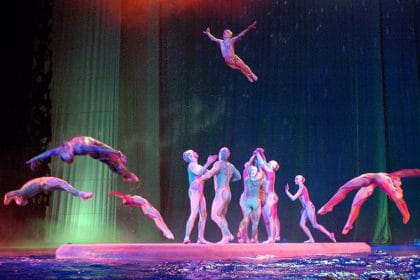
Quite understandably, Sallaway’s favourite memory of her time at Sheridan was meeting her future husband Brian who was in the four-year Athletic Therapy degree program. He also works for Cirque du Soleil in Las Vegas, supporting a different show. She adds that the “rigorous exams and demands of the placement made you geared up to work hard, deal with stress and keep problem-solving – which is invaluable if you’re in a high-pressure situation. I really appreciate the challenge we had in our education.” Sallaway also feels fortunate to have learned from outstanding teachers who are active in the field. “I still hear Anne Hartley’s name down here in the U.S.” Other professors, like Kirsty McKenzie have visited Sallaway. “The program created such a great network, which is a large basis for this career.”
At the end of the day, Sallaway says “I love my career and what I do every day. It’s such a tremendous profession for providing support for people’s athletic endeavours and it’s such a great feeling to be accepted into that role and help people achieve their goals.”
Becky Swan
Athletic Therapist, Employee Wellness Unit, Vancouver Police Department
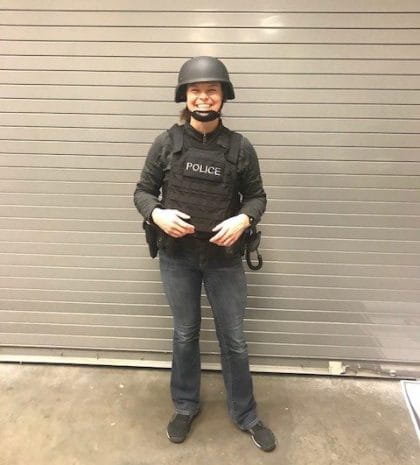
The Vancouver Police Department might not be the first place that comes to mind if you’re asked to guess where Sheridan’s Athletic Therapy graduates develop their careers. But in 2010, Becky Swan did just that when she responded to a posting for a fitness coordinator who could assist with training and recruitment.
“Within the first month and a half I saw how all of my skills as an Athletic Therapist could help.” Upon explaining that she could provide onsite treatment for officers because it was part of her certification, Swan was booked up within weeks. Her position now leads a therapy team in the Employee Wellness Unit that supports the Police Department’s 2,800+ staff members.
While Swan knows of multiple U.S. fire and police departments that employ Athletic Trainers, she describes the sector as still playing catch-up, especially in Canada. “When you think about it, people who work in tactical setting have all the elements that define an athlete. They need speed, agility and endurance. They have to be able to think. And yet, the consequences of not performing at an optimal level are so much more drastic. It’s almost hard for me to process why this hasn’t happened sooner.”
Swan says she found out about Sheridan’s program when she was in her second year studying Human Kinetics at the University of British Columbia, where she was also playing rugby and volunteering with some varsity sports teams. Her experience as a competitive skier since the age of six – the year she broke her leg, fractured her kneecap and needed surgery – also ingrained training and rehabilitation into her mind.
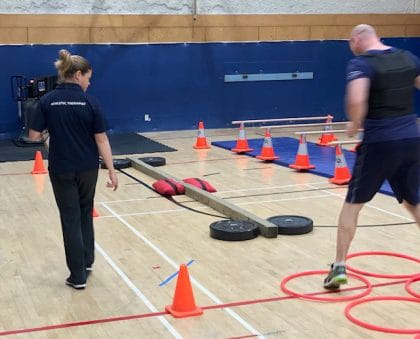
“I chose Sheridan because of all of the placements they provided – especially the one with the Hamilton Tiger Cats. I always wanted to work for a pro football team.” Not surprisingly, given her determination and enterprising nature, Swan succeeded in getting that scholarship. “I loved the experience, even if I didn’t own my life for a few months that summer. Working so many different clinical and field placements gave me great exposure. There’s something to be said for that experience and all that networking when you’re a student.”
Upon graduation from Sheridan, Swan got hired by Canada’s women’s soccer team. “I was with them in Juarez, Mexico in 2008 when they qualified for the Olympics for the very first time. I still remember the screams after that final goal and the giant mash-up on the field. To see them work so hard and get recognized made me so proud. I’ll never forget that moment.”
Swan recently completed a Masters degree in Rehabilitation Science at UBC, focusing on physical rehabilitation in police departments, and is excited about the future. “This is an amazing career with so many opportunities and I don’t think we’ve even realized all the places where we can utilize our skills as a profession. It can take a little out of the box thinking, but you’re definitely not stuck wearing just one label.”
Jennifer Johnson
Athletic Therapist and Owner, The S.M.A.R.T. clinic
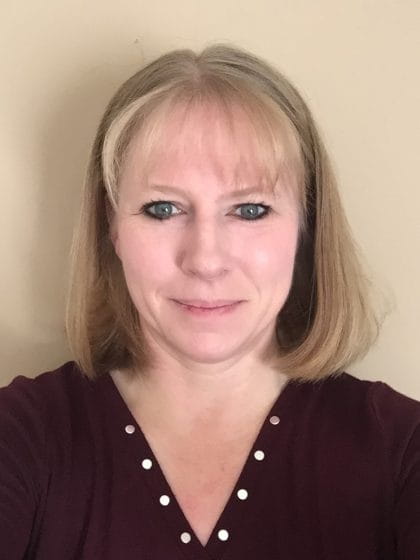
While the term industrial athlete might not be familiar to many, Jennifer Johnson describes this person as someone who does a physical job with a specific skill set that’s repetitive and that requires training. Much like the way that conditioning helps traditional athletes prevent injury from repetitive strain and perform at their best, the clients who come to the clinics Johnson has set up, in-house, at four industrial workplaces also have much to gain.
Johnson’s recalls meeting with a nurse at Purolator who was willing to explore how her profession could benefit their company. “We had a three-hour meeting and by the end of it, we had gone through the whole scope of practice of an Athletic Therapist. We had a plan of an industrial athlete from that meeting. Three months later I started there, just myself, treating workers. Within six months, I thought this could be scalable.” Johnson ran some numbers to show how she could reduce injures to protect workers and save companies money by keeping people at work while they recovered, since Athletic Therapy is rooted in an exercise-based approach to training and rehabilitation. A major milestone came when she secured her second client company. “I got the confidence to approach even more people which gave me the realization that this is not just a concept, it’s a career.”
Johnson currently employs eight Athletic Therapists. In addition to Purolator, she has a clinic at Honda Canada where they help prevent injuries for their workers, another at a food packaging company, and one more at a long-term care facility where they work with everyone from nurses and personal support workers to cooks and housekeepers. While much of her day is spent managing her company, directing the work, and growing her business, she’s also kept a private clinic in her home because she loves to treat patients.
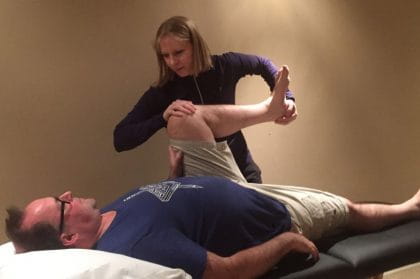
“Sheridan was the best place I could have studied – and I had my sights on the school for a long time.” She knew she wanted to be somewhere that had a small school feel, a program that was fully dedicated to Athletic Therapy, and that used a hands-on approach to teaching. “We learned anatomy, treatment, emergency care, and time management. The practical experience I got prepared me to jump right into the working world, without feeling like a newbie, and start treating people.”
As for the future of the profession, Johnson thinks it can only grow. “I get excited when I think about what more Athletic Therapists could be doing out there. This is a great line of work. It’s full of passionate people and there’s so much room to think about the different ways to apply your skills, without being conventional. Really, I think Athletic Therapy can help everyone.”
Pictured at top of page (left to right, clockwise): Sheridan alumna and Athletic Therapist Michelle Bell, Becky Swan working with an officer at the Vancouver Police Department, performers in Cirque du Soleil’s “O” in Las Vegas.
Story written by: Christine Szustaczek, Chief Communications Officer at Sheridan.
Media Contact
For media inquiries, contact Sheridan’s Communications and Public Relations team.

